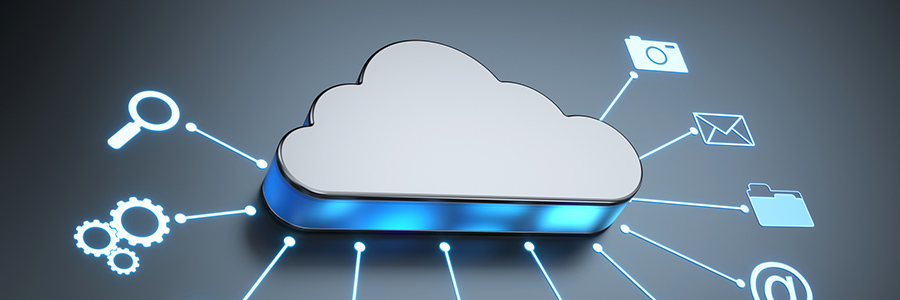Does my business need in-house servers, or should I migrate to the cloud?
When it comes to where you should keep your business apps and company data, you may use in-house servers, or you may migrate some or all of your apps and data to the cloud instead. Which one would be best for your small business? The answer is: it depends on what your business needs.

Check your business requirements
To arrive at something more definite, let’s take a look at which business requirements each option fulfills best — and where they may come up short.
In-house server
- Allows you to set up your IT system the way you need it to be
If you have particular system requirements, a cloud service provider (CSP) might not be able to accommodate you. Owning your own infrastructure grants you total control over it. - Grants greater data privacy
By keeping critical data in an on-premises (on-prem) facility, you get to safeguard it more closely. When it comes to who may access your information, you don’t need to worry about CSPs and their clients. Because of this, firms in industries with strict data regulations deem in-house servers to be a good fit for their needs. - Data access is not reliant on internet connectivity
If your business is located in an area with few to no internet service providers, then in-house servers are your only viable option. - Requires considerable investment in machines, software licenses, and network infrastructure
You’ll also have to factor in power consumption costs, maintenance and repair costs, and the risk of obsolescence, among other concerns. - Requires physical space and in-house IT support
Your data capacity is dependent on the availability of physical space for server racks and closets on site. You may have to rent additional space to set up server rooms, and install the necessary devices for climate control, access, and security monitoring. Additionally, you’ll need to employ full-time IT staff to take care of your machines. - Data is vulnerable to disasters such as fires and flash floods
Whatever emergency situation befalls your office will likely affect the servers you keep there. You’ll need to set up a process for taking backups off site to prevent complete data loss during an adverse event.
Cloud services
- Guarantees high levels of uptime
Web-based businesses have less risk of downtime due to 24/7 monitoring and other CSP protocols. - Provides greater scalability
Unlike on-prem solutions that have capacity constraints due to limited office space, the cloud lets clients increase or decrease the amount of IT resources they use as needed. - Data backups are less vulnerable to disasters
Natural calamities and man-made disasters that affect your office are likely not to reach off-site data backups. Additionally, CSPs can help facilitate business continuity and disaster recovery efforts to minimize downtime. - Uptime guarantees and other added-value cloud services increase costs
Firms that don’t need high levels of uptime may end up overpaying for cloud services. - Greater risk of overspending
Cloud resource management mistakes, such as provisioning too many resources when these are not yet needed, can easily lead to overspending on the cloud. Fortunately, managed IT services providers like [company_short] can help you handle your cloud. - Cloud service is reliant on internet connectivity
If you or your CSP lose internet access, then you’ll lose access to your data. However, this risk can be mitigated by having backup internet service providers.
Check what other businesses are doing
Another way to guide your decision-making is by looking at which option other companies are going for. Retail and B2B transaction data provider NPD noted that from January to May 2021, more companies invested in the cloud than in on-premises solutions. NPD determined this by tracking companies’ software purchases: year-over-year growth for B2B software for the cloud was 12%, whereas growth for on-prem was 6%. In 2020, Deloitte observed that while companies will continue to opt for a hybrid cloud model — i.e., one in which a company uses a mix of public and private clouds and also retains some on-prem capabilities — migration to the cloud is accelerating.
This is happening partly because businesses are learning from their past mistakes and are becoming better cloud users. Here are five things that they’re doing when migrating and adopting the cloud:
1. Shifting from public to private clouds
Private clouds may be more expensive than public ones, but data is safer and workloads run faster there. And when seeking technical support, private cloud clients don’t have to wait in line as long as public cloud tenants do.
2. Prioritizing security when developing cloud-based business apps
Oftentimes, moving to the cloud necessitates the creation of bespoke cloud-based apps to replace on-prem software. Initially, in their rush to migrate, developers prioritized functionality and patched vulnerabilities only after releasing their apps. This made for clunky security workarounds that failed to significantly reduce the risk of data breaches.
However, what used to be an afterthought in app development is now becoming a primary consideration. More and more developers are baking in security measures, such as access management and encryption in transit and at rest, from the very beginning of the development process.
3. Refraining from dumping data onto the cloud
In the early days of the cloud, it may have been cheap to store data there. Over time, however, retrieving the data back to on-prem servers has proved to be time-consuming and expensive. Now, companies are reserving cloud data storage for safety measures such as backups.
4. Using storage devices to transfer data to the cloud
The information superhighway is no longer sufficient to facilitate the backing up of vast volumes of data produced by enterprises to the cloud. This is why companies are now using migration appliances such as Google’s Transfer Appliance. The cloud service provider ships the appliance to where the data is. Once the data is saved on the appliance, the data owner then ships the device right back to the CSP, which will upload the data to the cloud.
5. Migrating workloads to the cloud, not non-backup data
Many regulations and privacy laws now limit where companies can store data. This, plus security concerns like man-in-the-middle attacks, makes storing data on premises the easier and less complicated choice.
However, since apps don’t need to be co-located with data, apps can reside in the cloud so that they can leverage its vast processing power.
Our IT experts at NetWize can help you design the IT infrastructure that fits your business best. Leave us a message or call us at 801-747-3200 today to learn more.
